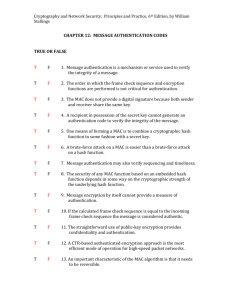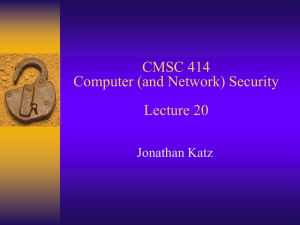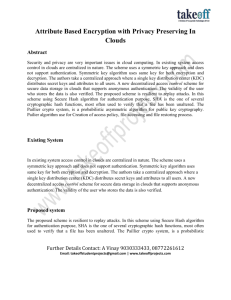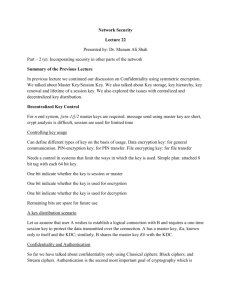lecture 7.2
advertisement
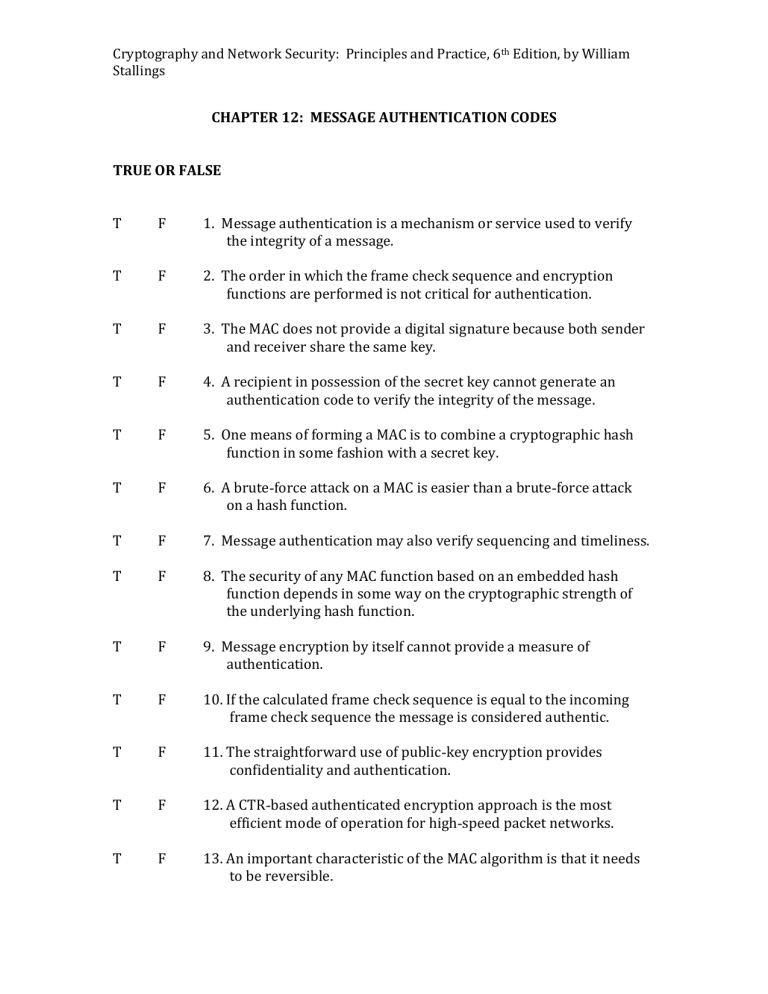
Cryptography and Network Security: Principles and Practice, 6th Edition, by William Stallings CHAPTER 12: MESSAGE AUTHENTICATION CODES TRUE OR FALSE T F 1. Message authentication is a mechanism or service used to verify the integrity of a message. T F 2. The order in which the frame check sequence and encryption functions are performed is not critical for authentication. T F 3. The MAC does not provide a digital signature because both sender and receiver share the same key. T F 4. A recipient in possession of the secret key cannot generate an authentication code to verify the integrity of the message. T F 5. One means of forming a MAC is to combine a cryptographic hash function in some fashion with a secret key. T F 6. A brute-force attack on a MAC is easier than a brute-force attack on a hash function. T F 7. Message authentication may also verify sequencing and timeliness. T F 8. The security of any MAC function based on an embedded hash function depends in some way on the cryptographic strength of the underlying hash function. T F 9. Message encryption by itself cannot provide a measure of authentication. T F 10. If the calculated frame check sequence is equal to the incoming frame check sequence the message is considered authentic. T F 11. The straightforward use of public-key encryption provides confidentiality and authentication. T F 12. A CTR-based authenticated encryption approach is the most efficient mode of operation for high-speed packet networks. T F 13. An important characteristic of the MAC algorithm is that it needs to be reversible. Cryptography and Network Security: Principles and Practice, 6th Edition, by William Stallings T F 14. As with encryption algorithms and hash functions cryptanalytic attacks on MAC algorithms seek to exploit some property of the algorithm to perform some attack other than an exhaustive search. T F 15. To attack MD5, the attacker can choose any set of messages and work on these offline on a dedicated computing facility to find a collision. MULTIPLE CHOICE 1. _________ encryption provides authentication among those who share the secret key. A. Message B. Asymmetric C. Symmetric D. Authenticated 2. The __________ mode of operation is designed to be parallelizable so that it can provide high throughput with low cost and low latency. A. DAA B. CCM C. GCM D. CTR 3. Insertion of messages into the network from a fraudulent source is a __________ attack. A. content modification B. masquerade C. source repudiation D. sequence modification 4. Confidentiality can be provided by performing message encryption __________ the MAC algorithm. A. before B. before or after C. after D. during 5. A __________ is an algorithm that requires the use of a secret key. Cryptography and Network Security: Principles and Practice, 6th Edition, by William Stallings A. DAA B. SHA C. GCM D. MAC 6. "Release of message contents to any person or process not possessing the appropriate cryptographic key" is a __________ attack. A. content modification B. source repudiation C. disclosure D. sequence modification 7. With _________ authentication an opponent would have difficulty generating ciphertext that when decrypted would have valid error control bits. A. checksum B. CMAC C. cipher block chaining D. internal error control 8. The MAC function is a __________ function. A. one-to-many B. many-to-one C. one-to-one D. one-to-two 9. The appeal of __________ is that its designers have been able to prove an exact relationship between the strength of the embedded hash function and the strength of this form of authentication. A. MAC B. HMAC C. GMAC D. CMAC 10. The _________ attack is when the attacker is looking for two messages M and M1 that produce the same hash: H(M) = H(M1) A. birthday B. chaining C. MAC D. hash Cryptography and Network Security: Principles and Practice, 6th Edition, by William Stallings 11. Two MACs that are based on the use of a block cipher mode of operation are Data Authentication Algorithm and __________ . A. GMAC B. DMAC C. TMAC D. CMAC 12. The key algorithmic ingredients of _________ are the AES encryption algorithm, the CTR mode of operation, and the CMAC authentication algorithm. A. DAA B. GCM C. CCM D. CMA 13. The GCM mode makes use of two functions: __________, which is a keyed hash function, and GCTR. A. CTR B. HMAC C. GHASH D. CCM 14. The essential elements of any pseudorandom number generator are a __________ and a deterministic algorithm for generating a stream of pseudorandom bits. A. secret key B. session key C. seed value D. stream encryption function 15. The approach taken by the Transport Layer Security protocol and the Wireless Transport Layer Security Protocol involve invoking HMAC _________ for each block of output wi. A. zero times B. twice C. three times D. once

